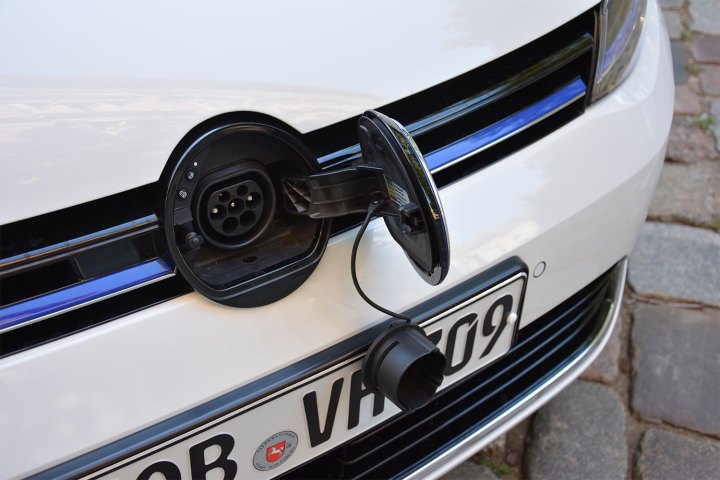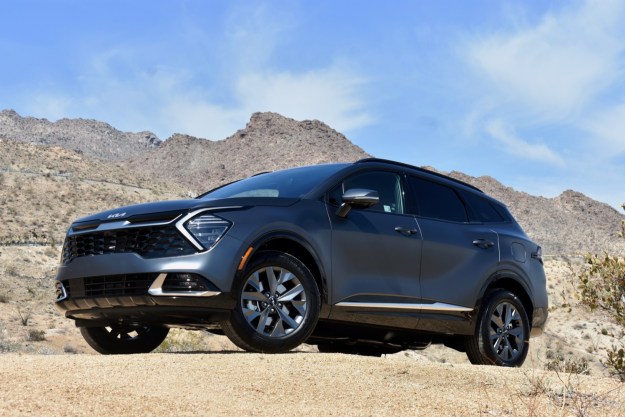The Volkswagen Golf GTE is an unusually fun hybrid, but it falls short of being an electrified GTI.
Up until recently, hybrids fulfilled the mission of providing numb, neutered, and efficient transportation. That began to change when automakers realized they could put instant torque to good use and build a fast, efficient sports car. The Porsche 918 Spyder and the Acura NSX are two excellent examples of what hybrids are capable of when they’re put on steroids, but they’re out of the reach of most motorists.
Volkswagen has taken the basic idea of a sports-focused hybrid and condensed it into a practical package that’s a lot more affordable. I’m not talking about a futuristic concept or a prototype, either; the Golf GTE has been on sale across Europe – where it’s one of the best-selling plug-in models – for over two years.
The GTE nameplate doesn’t ring a bell in the United States because it’s not sold here. However, Volkswagen of America CEO Hinrich Woebcken told me that the brand’s top executives are debating whether or not to send the GTE across the pond in the not-too-distant future. Intrigued, I hopped behind the wheel of one in Berlin, Germany, for a quick spin.
Under the skin
The Golf GTE is closely related to the Audi A3 e-tron. Its gasoline-electric drivetrain is built around a 1.4-liter four-cylinder TSI engine that provides 148 horsepower and 184 pound-feet of torque. It works jointly with an electric motor programmed to generate 101 horses and 243 pound-feet of twist. Electricity comes from an 8.7-kWh lithium-ion battery pack mounted over the rear axle, a packaging solution that eats up a little bit of trunk space.
Calculating the system’s total output isn’t as simple as adding the motor’s power to the engine’s power, however. With both sources running, the driver has access to 204 horsepower and 258 pound-feet of torque. In comparison, the base GTI posts figures of 210 and 258, respectively. A six-speed dual-clutch automatic transmission spins the front wheels regardless of where the forward momentum comes from.
It takes a well-trained eye to tell the GTE apart from a standard Golf, which is exactly what designers were aiming for.
The GTE looks like… well, a four-door Golf. Model-specific touches include blue accents on both ends, C-shaped LED daytime running lights up front, and discreet GTE emblems on the fenders. It takes a well-trained eye to tell the GTE apart from a standard Golf, which is exactly what designers were aiming for. If they wanted a car that looks like a hybrid from a hundred yards away they would have followed Hyundai’s path and designed a Prius clone.
The story is the same on the inside. If you’ve driven a Golf, you’ll feel right at home in the GTE. The cabin is well-built, spacious, and ergonomic. The front passengers are treated to comfortable sport seats upholstered with blue tartan upholstery created specifically for the GTE. Another noticeable difference that nods to its hybrid heart is the tachometer, which has been replaced by a power gauge.
Three cars in one
A menu built into the infotainment system lets the driver select whether the GTE runs on electricity, gasoline, or both. The hybrid and electric modes can also be engaged using switches located next to the gear selector on the center console.
In terms of traffic, Berlin is just like every other big city in Europe. It’s crowded, and you’re constantly stopping for lights, buses, motorcyclists, joggers, and jet-lagged tourists. It’s in this environment that the GTE best flaunts its green credentials by running exclusively on electricity. It feels a lot like an e-Golf because it’s as quiet as a cathedral, it’s zippy off the line, and the brake energy recuperation system can bring the GTE to a full stop on its own in ordinary city driving.
The European Union’s fantastically optimistic testing procedure for electrified cars claims the GTE is good for 31 miles on watts alone, but the real-world figure is closer to 20. That’s still usable, and as long as there’s electricity left in the battery pack there’s no need for the TSI engine provided the speedometer doesn’t exceed 81 mph.
The Golf has always been one of the more refined cars in its segment and the GTE is no exception.
There are several ways to run the GTE on both gasoline and electricity. As a basic hybrid, it relies on the two power sources to return the best possible gas mileage. Power delivery is smooth and instantaneous, and the transition between the electric motor and the TSI engine is seamless. The Golf has always been one of the more refined cars in its segment and the GTE is no exception..
GTE mode puts a focus on performance; it’s the driving mode that’s supposed to get your heart racing. The Golf GTE is perceptibly faster and much more dynamic to drive than the average family hybrid, but on a winding road it becomes obvious that this hatchback isn’t an electrified GTI. At 3,481 pounds the GTE is over 300 pounds heavier than the base GTI, and the extra weight makes its presence known when the pace picks up. The sharp steering is excellent but it’s not as precise as the GTI’s, and the GTE lacks the nimbleness that has characterized Volkswagen’s hot hatch for seven generations.
Battery hold mode saves the battery’s charge for later in the trip. Finally, battery charge mode tops up the pack on-the-go so commuters can skip a trip to the charging station. With only the TSI spinning the front wheels, the GTE drives just like a Euro-spec 1.4-liter Golf with a few hundred extra pounds to lug around. Battery charge lives up to its promise of topping up the pack but it does so at the expense of gas mileage. A full charge takes a little over two hours when the Golf is plugged into a wall box, so city dwellers who plan ahead can avoid engaging battery charge mode altogether.
Conclusion
The Volkswagen GTE isn’t quite as sporty as its nameplate suggests, but driving it is the most fun I’ve had behind the wheel of a hybrid that doesn’t cost as much as a house. It provides an addicting blend of performance and zero-emissions motoring without the burden of range anxiety.
The downside to the GTE is that the technology it relies on isn’t cheap to design or build, so it’s one of the more expensive variants of the Golf on the market. Luckily, generous incentives awarded to motorists who take home an electrified car bring the dollar figure down to a more reasonable amount.
I hope Volkswagen decides to bring the Golf GTE to the United States. It wouldn’t be a volume seller, but it’s exactly the kind of halo car that the brand needs right now.
Highs
- Usable electric range
- Zippy off the line
- No range anxiety
- Comfortable, well-built cabin
Lows
- Battery pack adds weight
- Limited electric range
- Expensive
Editors' Recommendations
- Volkswagen ID.4 vs Tesla Model Y
- Volkswagen is launching its own self-driving car testing program in the U.S.
- Volkswagen ID.7 shows not every EV needs to be an SUV
- Hyundai Ioniq 6 first drive review: welcome to the future
- 2023 Kia Niro EV first drive review: Practical doesn’t have to bore you to tears













